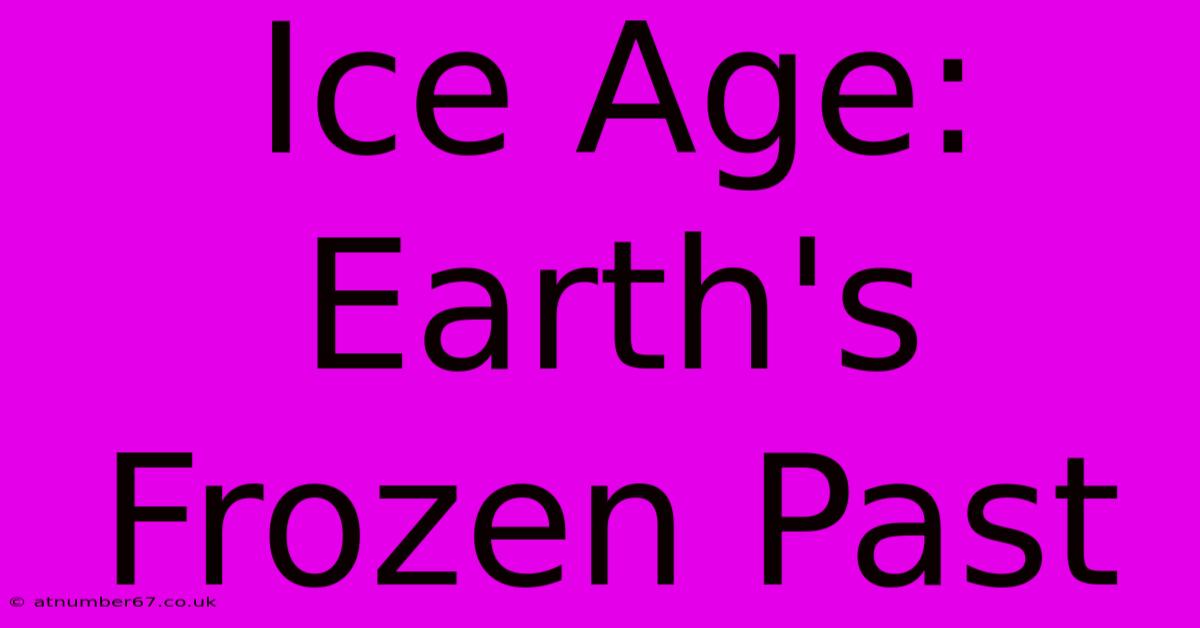Ice Age: Earth's Frozen Past

Table of Contents
Ice Age: Earth's Frozen Past - A Deep Dive into Glacial Periods
The Ice Age. A phrase conjuring images of woolly mammoths, saber-toothed cats, and vast, frozen landscapes. But what exactly was the Ice Age, and what can its frozen past tell us about our planet's future? This article delves into the fascinating history of Earth's glacial periods, exploring their causes, effects, and the invaluable lessons they hold for understanding climate change today.
Understanding Glacial Periods: More Than Just One Ice Age
The term "Ice Age" is often misleading. It wasn't a single, prolonged period of freezing, but rather a series of glacial periods interspersed with warmer interglacial periods, like the one we're currently in. These cycles have occurred repeatedly throughout Earth's history, dramatically reshaping landscapes and impacting life on Earth. The most recent Ice Age, which began around 2.6 million years ago, is known as the Quaternary glaciation, and it's the one that most readily comes to mind when we hear the term "Ice Age."
Key Characteristics of Glacial Periods:
- Extensive Ice Sheets: Massive ice sheets, kilometers thick, covered significant portions of the continents, particularly North America, Europe, and Asia.
- Lower Sea Levels: As water was locked up in ice sheets, global sea levels dropped dramatically, exposing land bridges and altering coastlines.
- Altered Ecosystems: Flora and fauna adapted to the colder, harsher conditions, leading to the evolution of unique species like the woolly mammoth and the giant ground sloth.
- Climate Shifts: Glacial periods were characterized by significantly colder temperatures, increased snowfall, and dramatic changes in atmospheric circulation patterns.
What Caused the Ice Ages? A Complex Interplay of Factors
The precise causes of glacial periods are still a subject of ongoing research, but several key factors are believed to have played crucial roles:
1. Milankovitch Cycles: Orbital Variations
These cyclical changes in Earth's orbit around the sun affect the amount of solar radiation received at different latitudes. These variations, though subtle, can trigger significant long-term climate changes over tens of thousands of years.
2. Greenhouse Gas Concentrations: A Delicate Balance
The concentration of greenhouse gases in the atmosphere plays a critical role in regulating Earth's temperature. Lower concentrations, as seen during glacial periods, contribute to cooling.
3. Tectonic Plate Movement: Shifting Continents
The slow movement of tectonic plates influences ocean currents and atmospheric circulation patterns, ultimately impacting global climate.
4. Feedback Mechanisms: Amplifying Effects
Once a cooling trend begins, various feedback mechanisms can amplify the effects, creating a positive feedback loop. For example, increased ice cover reflects more sunlight back into space, further reducing temperatures.
The Impact of Ice Ages: Shaping Our World
Ice ages have profoundly shaped the world we inhabit today. The massive ice sheets carved out valleys, formed lakes, and left behind deposits of sediment that are rich in geological information. The movement of ice sheets also altered drainage patterns, creating the Great Lakes of North America, for instance. Furthermore, the fluctuating sea levels during glacial cycles exposed land bridges, allowing for the migration of plants and animals, impacting the distribution of species around the globe.
Lessons from the Ice Age: Understanding Climate Change Today
Studying past ice ages provides invaluable insights into the dynamics of Earth's climate system. By analyzing ice cores, sediment layers, and other geological records, scientists can reconstruct past climates and understand the processes that drove glacial cycles. This knowledge is crucial for understanding and predicting the effects of current climate change, allowing us to better assess the potential consequences of rising greenhouse gas emissions and develop effective mitigation strategies.
In conclusion, the Ice Age is far more than just a frozen period in Earth's history. It's a complex story of climate change, geological transformation, and biological adaptation. By studying this frozen past, we gain a deeper understanding of our planet's intricate climate system and equip ourselves with the knowledge needed to navigate the challenges of our warming world. The study of past ice ages offers a crucial perspective on the urgent need for responsible environmental stewardship in the face of modern climate change.

Thank you for visiting our website wich cover about Ice Age: Earth's Frozen Past. We hope the information provided has been useful to you. Feel free to contact us if you have any questions or need further assistance. See you next time and dont miss to bookmark.
Featured Posts
-
Tom Hanks Son A Modern Story Of Family And Legacy
Apr 12, 2025
-
Dj Toxic Son Of Dragon Hear The Difference
Apr 12, 2025
-
The Secrets Behind Tommy Salos Impressive Net Worth
Apr 12, 2025
-
Unlocking The Sugar Puzzle Tablespoons To Grams
Apr 12, 2025
-
Alysha Burney Her Path To Wealth And Success
Apr 12, 2025
